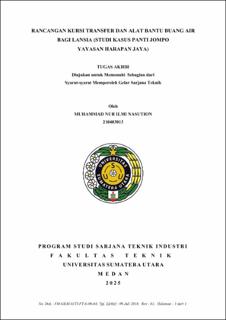Rancangan Kursi Transfer Elektrik dan Alat Bantu Buang Air Bagi Lansia (Studi Kasus di Panti Jompo Yayasan Harapan Jaya)
Development of an Electric Transfer Chair and Assisted Defecation Device for the Elderly: A Case Study at the Harapan Jaya Nursing Home

Date
2025Author
Nasution, Muhammad Nur Ilmi
Advisor(s)
Anizar
Nasution, Fadylla Ramadhani Putri
Metadata
Show full item recordAbstract
Manual Handling (MH) refers to any activity that requires physical effort
and is performed to lift, lower, push, pull, move, hold, or restrain an object or
person. Mobility limitations among the elderly often become a major obstacle in
performing basic daily activities, including transferring between locations and
toileting. Panti Jompo Yayasan Harapan Jaya, as one of the elderly care institutions
in Indonesia that provides holistic care for the elderly, faces a significant issue: the
absence of assistive devices to facilitate independent transfers for elderly
individuals. This condition has led to physical complaints in several body parts due
to manual transfer processes without proper assistance, as evidenced by the Nordic
Body Map questionnaire. Therefore, a support tool that is not only functional but
also ergonomic is highly necessary. This study aims to design an electric transfer
chair integrated with a toileting aid to improve user comfort, safety, and
independence. The design process employs the Nordic Body Map method to identify
discomfort points and potential musculoskeletal risks in the user's body.
Anthropometric data is also used to ensure that the chair dimensions correspond to
the average physical characteristics of users in Indonesia. The research stages
include problem identification, data collection using the Nordic Body Map
questionnaire, anthropometric measurements, design requirement analysis, and the
development of product concepts and a 3D model. The results show that the use of
an electric motor in the chair’s drive system facilitates the user’s transfer process
from bed to bathroom. Furthermore, the integrated seat design with a built-in
toileting feature simplifies the process of excretion without the need for relocation.
This product is expected to reduce the risk of injury due to manual movement. With
an ergonomic and technological approach, the design offers an innovative solution
to enhance the quality of life for individuals with physical limitations. This research
also contributes to the development of more adaptive and inclusive assistive product
designs.
Collections
- Undergraduate Theses [1597]
